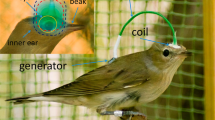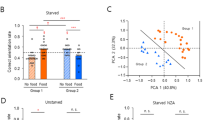Summary
-
1.
The orientation of fresh-water snails (Physa pomillia) in a symmetrical magnetic field was studied from February to March and from September to October, 1965, during the hours 8:30 to 17:30.
-
2.
The orientation of the snails was studied in an augmented magnetic field, 9 times that of the earth's field at Gainesville, Florida, with a bar magnet aligned parallel and at right angles to the earth's magnetic field. Control experiments were performed with the bar magnet removed from the apparatus. Possible effects of the magnetic field were tested under two different light conditions, using a window centered above the orientation platform, and one placed above and ahead of it.
-
3.
Under the given experimental conditions the snails showed no significant right- or left-turning.
-
4.
The time of year did not appear to affect the behavior of the snails in the arena.
-
5.
Snails moving in the uniformly diffuse light from the centered window scattered over the whole range of the arena. Snails in the light gradient caused by the eccentric window oriented toward the point on the floor of the arena at which the light intensity was greatest (positive phototaxis).
-
6.
Physa pomillia did not orient with respect to the direction and strength of the magnetic fields used.
Zusammenfassung
Im Frühjahr und Herbst 1965 wurde das Orientierungsverhalten der Süßwasserschnecke Physa pomillia in einem künstlichen, von einem Stabmagneten erzeugten Magnetfeld untersucht, das dem Neunfachen des natürlichen Magnetfeldes am Untersuchungsort in Gainesville, Florida entsprach. Der Stabmagnet war im Versuchsapparat unter der Arena parallel und im rechten Winkel zum Magnetfeld der Erde angebracht; in Kontrollversuchen wurde er entfernt.
Die Versuche wurden in diffusem Licht unter einem exakt über der Lauffläche zentrierten Fenster und, zur Kontrolle von möglichen Beeinflussungen des Orientierungsverhaltens durch ein schwaches Lichtgefälle, unter einem der Arena vorgelagerten Fenster durchgeführt. Letztere Anordnung entsprach den Angaben anderer Autoren (l.c.).
Im Gefälle des exzentrisch angeordneten diffusen Lichtes waren die Schnecken zur Stelle größter Lichtintensität im Sinne einer positiven Phototaxis orientiert. Im zentriert diffusen Licht waren sie in jeder Versuchssituation mit oder ohne Stabmagnet unorientiert. Eine Orientierung der Schnecken nach den Magnetfeldern war nicht nachzuweisen. Die einzelnen Versuchsbefunde stimmten in beiden Jahreszeiten überein.
Similar content being viewed by others
References
Barnwell, F. H.: A day-to-day relationship between oxidative metabolism and world-wide geomagnetic activity. Biol. Bull. 119 (2), 303 (1960).
—, and F. A. Brown jr.: Magnetic and photic responses in snails. Experientia (Basel) 17 (513), 1–7 (1961).
— —: Responses of planarians and snails, p. 263–278, in: Biological Effects of Magnetic Fields (M. F. Barnothy, ed.). New York: Plenum Press 1964.
—, and H. M. Webb: Responses of the mud snail, Nassarius, to experimental reversals in direction of very weak magnetic fields. Biol. Bull. 121 (2), 381 (1961).
Brown jr, F. A.: How animals respond to magnetism. Discovery, November, 1963.
—, and F. H. Barnwell: Magnetic field strength and organismic orientation. Biol. Bull. 119 (2), 306 (1960).
— —: Organismic orientation relative to magnetic axes, in responses to weak magnetic fields. Biol. Bull. 121 (2), 384 (1961).
— —, and H. M. Webb: Adaptation of the magnetoreceptive mechanism of mud-snails to geomagnetic strength. Biol. Bull. 127 (2), 221–231 (1964).
Brown jr., F. A., M. F. Bennett, and W. J. Brett: Effects of imposed magnetic fields in modifying snail orientation. Biol. Bull. 117 (2), 406 (1959).
— —, and H. M. Webb: A magnetic compass response of an organism. Biol. Bull. 119 (1), 65–74 (1960).
—, W. J. Brett, M. F. Bennett, and F. H. Barnwell: Magnetic response of an organism and its solar relationships. Biol. Bull. 118 (3), 367–381 (1960).
—, and H. M. Webb: A “Compass-direction effect” for snails in constant conditions, and its lunar modulation. Biol. Bull. 119 (2), 307 (1960).
— —, and F. H. Barnwell: A compass directional phenomenon in mud-snails and its relation to magnetism. Biol. Bull. 127 (2), 206–220 (1964).
— —, and W. J. Brett: Exogenous timing of solar and lunar periodisms in metabolism of the mud-snail, Ilyanassa (Nassarius) obsoleta, in laboratory constant conditions. Gunma J. med. Sci. 8 (3), 233–242 (1959).
— — —: Magnetic response of an organism and its lunar relationships. Biol. Bull. 118 (3), 382–392 (1960).
Schneider, F.: Systematische Variationen in der elektrischen, magnetischen und geographisch-ultraoptischen Orientierung des Maikäfers. Vjschr. naturforsch. Ges. Zürich 108, 373–416 (1963a).
—: Ultraoptische Orientierung des Maikäfers (Melolontha vulgaris F.) in künstlichen elektrischen und magnetischen Feldern. Ergebn. Biol. 26, 147–157 (1963b).
Webb, H. M., F. A. Brown jr., and W. J. Brett: Effects of imposed electrostatic field on rate of locomotion in Ilyanassa. Biol. Bull. 117 (2), 430 (1959).
—, and T. E. Schroeder: Organismic responses to differences in weak horizontal electrostatic fields. Biol. Bull. 121 (2), 413 (1961).
Author information
Authors and Affiliations
Additional information
Research project performed in fulfillment of the requirements for Ethology (Zy 671) and Animal Orientation and Biological Clocks (Zy 690) under the direction of E. G. F. Sauer, Department of Zoology, University of Florida, Gainesville, Florida 32601.
Rights and permissions
About this article
Cite this article
Badman, D.G. Effects of light on the orientation of the snail Physa pomillia in a weak magnetic field. Psychol. Forsch. 29, 360–371 (1966). https://doi.org/10.1007/BF00421756
Received:
Issue Date:
DOI: https://doi.org/10.1007/BF00421756




